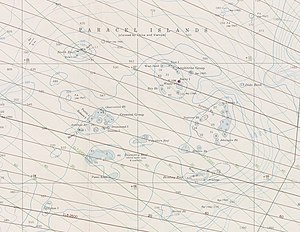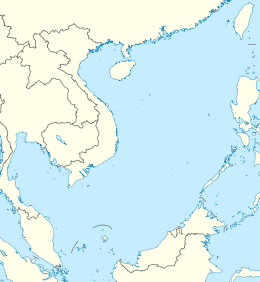
Back جزر باراسيل Arabic Islles Paracel AST Парасельскія астравы Byelorussian Парацэльскія астравы BE-X-OLD Параселски острови Bulgarian প্যারাসেল দ্বীপপুঞ্জ Bengali/Bangla Inizi Paracel Breton Illes Paracel Catalan Paracel Islands CEB Paracelské ostrovy Czech
| Disputed islands | |||||||||||||||||
|---|---|---|---|---|---|---|---|---|---|---|---|---|---|---|---|---|---|
 Nautical chart of the Paracel Islands | |||||||||||||||||
| Geography | |||||||||||||||||
| Location | South China Sea | ||||||||||||||||
| Coordinates | 16°40′N 112°20′E / 16.667°N 112.333°E[1] | ||||||||||||||||
| Total islands | Over 30 | ||||||||||||||||
| Major islands | Woody, Rocky, Tree, Money, Robert, Pattle, Triton, Duncan, Lincoln, Drummond | ||||||||||||||||
| Area | 7.75 km2 (2.99 sq mi) (15,000 sq km ocean surface) | ||||||||||||||||
| Coastline | 518 km (321.9 mi) | ||||||||||||||||
| Highest elevation | 14 m (46 ft) | ||||||||||||||||
| Highest point | Rocky Island | ||||||||||||||||
| Administration | |||||||||||||||||
| Province | Hainan | ||||||||||||||||
| Prefecture-level city | Sansha | ||||||||||||||||
| District | Xisha District | ||||||||||||||||
| Claimed by | |||||||||||||||||
| Municipality | Kaohsiung | ||||||||||||||||
| Municipality | Da Nang | ||||||||||||||||
| Demographics | |||||||||||||||||
| Population | Over 1,000 (2014) | ||||||||||||||||
| Additional information | |||||||||||||||||
| Chinese name | |||||||||||||||||
| Simplified Chinese | 西沙群岛 | ||||||||||||||||
| Traditional Chinese | 西沙群島 | ||||||||||||||||
| Literal meaning | Western Sandy Archipelago | ||||||||||||||||
| |||||||||||||||||
| Vietnamese name | |||||||||||||||||
| Vietnamese | Quần đảo Hoàng Sa | ||||||||||||||||
| Hán-Nôm | 群島黃沙 | ||||||||||||||||
The Paracel Islands, also known as the Xisha Islands (simplified Chinese: 西沙群岛; traditional Chinese: 西沙群島; pinyin: xīshā qúndǎo; lit. 'West Sand Archipelago')[2] and the Hoàng Sa Archipelago (Vietnamese: Quần đảo Hoàng Sa, lit. 'Yellow Sand Archipelago'), are a disputed archipelago in the South China Sea.
The word paracel is of Portuguese origin, meaning placer (a submerged bank or reef), and appears on 16th-century Portuguese maps. The archipelago includes about 130 small coral islands and reefs, most grouped into the northeastern Amphitrite Group or the western Crescent Group. They are distributed over a maritime area of around 15,000 square kilometers (5,800 sq mi), with a land area of approximately 7.75 square kilometers (2.99 sq mi). The archipelago is located about 220 miles (350 km) southeast of Hainan Island, equidistant from the coastlines of the People's Republic of China (PRC) and Vietnam, and approximately one-third of the way between central Vietnam and the northern Philippines.[3] A unique feature of the Paracel Islands is Dragon Hole, the deepest underwater sinkhole in the world.[4][5] Sea turtles and seabirds are native to the islands, which have a hot and humid climate, abundant rainfall and may experience annual typhoons. The archipelago is surrounded by productive fishing grounds and a seabed containing potential, but still unexplored, oil and gas reserves.
The colonial government of French Indochina set up telecommunications and meteorology stations on Pattle Island in the Crescent Group, and Woody Island ('Boisée' in French) in the Amphitrite Group, in the 1930s, which they regularly maintained until 1945.[3] Imperial Japan established a military presence on the Paracel Islands during the Second Sino-Japanese War, Japanese troops lived alongside French troops on Woody Island throughout much of that conflict.[6] Japan, then at war with China, invaded the islands in 1939 on the pretext of their being a Chinese territory and placed them under the administration of Takao Prefecture in Japanese Taiwan in 1941.[7] After the end of the war, in 1946, the Republic of China sent naval expeditions to the South China Sea and established a garrison on Woody Island.[8] Later, in January 1947, French and Vietnamese forces landed on Pattle Island in the Crescent Group. By 1955, South Vietnam had taken possession of the Crescent Group. In 1956, the PRC took control of and established a permanent presence on Woody Island, which (by then) was only seasonally inhabited by fishermen from Hainan.[9] After the Battle of the Paracel Islands, in January 1974, the People's Republic of China expelled the South Vietnamese from the Crescent Group and took full control of the Paracels. South Vietnam's claim to the islands was inherited by the Socialist Republic of Vietnam, which has remained in-office since 1976.[10]
The ownership of the islands remains hotly contested. The People's Republic of China (PRC) on Mainland China, Vietnam, and the Republic of China (ROC) on Taiwan all claim de jure sovereignty, although the PRC has had de facto control of the archipelago since the Battle of the Paracel Islands in January 1974. In July 2012, China (PRC) established Sansha, Hainan Province, as administering the area.[11] In February 2017, the Asia Maritime Transparency Initiative reported 20 outposts of the PRC built on reclaimed land in the Paracels, three of which contain small harbours capable of berthing naval and commercial ships.[12]
- ^ Cite error: The named reference
ngawas invoked but never defined (see the help page). - ^ Jones, Gareth Wyn (2002). "Provinces". In Boland-Crewe, Tara; Lea, David (eds.). The Territories of the People's Republic of China. London: Europa Publications. p. 101. ISBN 978-0-203-40311-2.
- ^ a b "Paracel Islands". The World Factbook. CIA. Retrieved September 18, 2014.
- ^ "China Exclusive: South China Sea "blue hole" declared world's deepest". New China. news.xinhuanet.com. July 23, 2016. Archived from the original on July 24, 2016. Retrieved July 26, 2016.
- ^ "Researchers just discovered the world's deepest underwater sinkhole in the South China Sea". Washington Post. July 26, 2016. Archived from the original on July 27, 2016. Retrieved July 26, 2016.
- ^ Cite error: The named reference
STwas invoked but never defined (see the help page). - ^ "Japanese Occupation South China Sea Islands - 1937-1941}year=2012". combinedfleet.com.
- ^ Kivimäki (2002), p. 11.
- ^ Kivimäki (2002), p. 13.
- ^ "Vietnam". The National Bureau of Asian Research (NBR). Retrieved January 14, 2021.
- ^ "China sets up Sansha City to administer South China Sea islands". Sina. June 21, 2012. Archived from the original on March 3, 2016. Retrieved June 21, 2012.
- ^ "The Paracels: Beijing's Other South China Sea Buildup". www.amti.csis.org. Asia Maritime Transparency Initiative. February 8, 2017. Archived from the original on February 9, 2017. Retrieved February 9, 2017.
Cite error: There are <ref group=lower-alpha> tags or {{efn}} templates on this page, but the references will not show without a {{reflist|group=lower-alpha}} template or {{notelist}} template (see the help page).
© MMXXIII Rich X Search. We shall prevail. All rights reserved. Rich X Search
